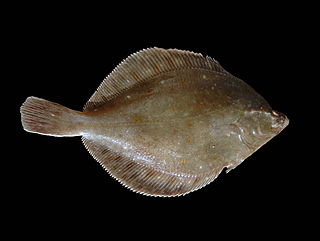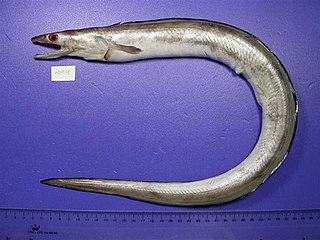
The Percidae are a family of ray-finned fish, part of the order Perciformes, which are found in fresh and brackish waters of the Northern Hemisphere. The majority are Nearctic, but there are also Palearctic species. The family contains more than 200 species in 11 genera. The perches and their relatives are in this family; well-known species include the walleye, sauger, ruffe, and three species of perch. However, small fish known as darters are also a part of this family.

Salmonidae is a family of ray-finned fish that constitutes the only currently extant family in the order Salmoniformes, consisting of 11 extant genera and over 200 species collectively known as "salmonids" or "salmonoids". The family includes salmon, trout, char, graylings, freshwater whitefishes, taimens and lenoks, all coldwater mid-level predatory fish that inhabit the subarctic and cool temperate waters of the Northern Hemisphere. The Atlantic salmon, whose Latin name became that of its genus Salmo, is also the eponym of the family and order names.

The blennioid family Chaenopsidae includes the pike-blennies, tube-blennies, and flagblennies, all percomorph marine fish in the order Blenniiformes. The family is strictly tropical, ranging from North to South America. Members are also present in waters off Japan, Taiwan and Korea. Fourteen genera and 91 species are represented, the largest being the sarcastic fringehead, Neoclinus blanchardi, at 30 cm (12 in) in length; most are much smaller, and the group includes perhaps the smallest of all vertebrates, Acanthemblemaria paula, measuring just 1.3 cm (0.51 in) long as an adult.

The Congridae are the family of conger and garden eels. Congers are valuable and often large food fishes, while garden eels live in colonies, all protruding from the sea floor after the manner of plants in a garden. The family includes over 220 species in 32 genera.

Pleuronectidae, also known as righteye flounders, are a family of flounders. They are called "righteye flounders" because most species lie on the sea bottom on their left sides, with both eyes on their right sides. The Paralichthyidae are the opposite, with their eyes on the left side. A small number of species in Pleuronectidae can also have their eyes on the left side, notably the members of the genus Platichthys.

Sander is a genus of predatory ray-finned fish in the family Percidae, which also includes the perches, ruffes, and darters. They are also known as "pike-perch" because of their resemblance to fish in the unrelated Esocidae (pike) family. They are the only genus in the monotypic tribe Luciopercini, which is one of two tribes in the subfamily Luciopercinae.

The superorder Elopomorpha contains a variety of types of fishes that range from typical silvery-colored species, such as the tarpons and ladyfishes of the Elopiformes and the bonefishes of the Albuliformes, to the long and slender, smooth-bodied eels of the Anguilliformes. The one characteristic uniting this group of fishes is they all have leptocephalus larvae, which are unique to the Elopomorpha. No other fishes have this type of larvae.

The daggertooth pike conger also known as the darkfin pike eel in Australia, to distinguish it from the related pike-eel, is a species of eel in the pike conger family, Muraenesocidae. They primarily live on soft bottoms in marine and brackish waters down to a depth of 800 m (2,600 ft), but may enter freshwater. They commonly grow to about 1.5 m (4.9 ft) in length, but may grow as long as 2.2 m (7.2 ft). Daggertooth pike congers occur in the Red Sea, on the coast of the northern Indian Ocean, and in the West Pacific from Indochina to Japan. A single specimen was also reported in the Mediterranean Sea off Israel in 1982.

Congiopodidae, commonly known as pigfishes, horsefishes and racehorses, is a family of ray-finned fish classified with in the order Perciformes. These fishes are native to the Southern Hemisphere.

The trumpetfishes are three species of highly specialized, tubularly-elongated marine fishes in the genus Aulostomus, of the monogeneric family Aulostomidae. The trumpetfishes are members of the order Syngnathiformes, together with the seahorses and the similarly built, closely related cornetfishes.

The Colocongridae, the worm eels or short-tail eels, are a family of eels, containing a single genus, Coloconger.

Eels are ray-finned fish belonging to the order Anguilliformes, which consists of eight suborders, 20 families, 164 genera, and about 1000 species. Eels undergo considerable development from the early larval stage to the eventual adult stage and are usually predators.

Muraenesox is a small genus of eels found throughout the Indo-Pacific. It currently has three described species as most species have been moved to other genera. Members are found in the Indo-West Pacific.

Cynoponticus is a genus of marine ray-fiined fishes belonging to the family Muraenesocidae, the pike congers. The fishes in this genus are found in the Eastern and Western Atlantic Oceans and the Eastern Pacific Ocean, with a single parapatric species in each region.
Congresox is a genus of marine ray-finned fishes belonging to the family Muraenesocidae, the pike congers. The fishes in this genus are found in the Indian and Pacific Oceans.
Oxyconger leptognathus, the shorttail pike conger, is an eel in the family Muraenesocidae. It is the only member of the genus Oxyconger. It is found in the western Pacific Ocean from Japan to Australia.
The yellow pike conger is a species of marine ray-finned fish belonging to the family Muraenesocidae, the pike congers. This fish is found in the Indian Ocean and the western Pacific Ocean.

Cynoponticus savanna,, the Guayana pike-conger, pike-headed eel or sapphire eel, is an eel in the family Muraenesocidae. It was described by Edward Nathaniel Bancroft in 1831, originally under the genus Conger. It is a marine, tropical eel which is known from the western Atlantic Ocean, including Central America, the Caribbean and Brazil. It dwells at a maximum depth of 100 metres (330 ft), and inhabits muddy substrates in bays and estuaries. Males can reach a maximum total length of 150 centimetres (59 in), but more commonly reach a TL of 50 centimetres (20 in).

Congroidei is a suborder of ray-finned fishes belonging to the order Anguilliformes, the eels. These eels are mostly marine, although a few species of snake eel will enter freshwater, and they are found in tropical and tempareate waters throughout the world.
Sauromuraenesox is a monospecific genus of marine ray-finned fish belonging to the family Muraenesocidae, the pike congers. The only species in the genus is Sauromuraenesox vorax which was described in 1889 by the British physician, naturalist and carcinologist Alfred William Alcock with its type locality given as the Bay of Bengal. This species is found in the northern Indian Ocean where it has been recorded off Oman, the Arabian and Andaman coasts of India, including Sri Lanka, east to Myanmar. This benthopelagic species is found over the continental shelf and upper slope over soft substrates at depths betwen 274 and 469 m.














